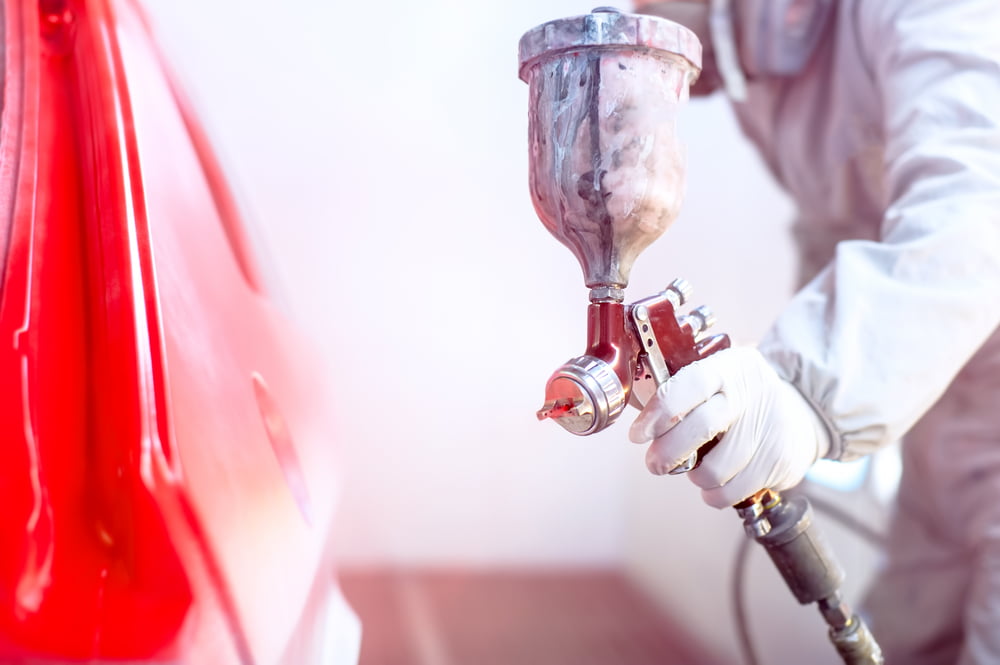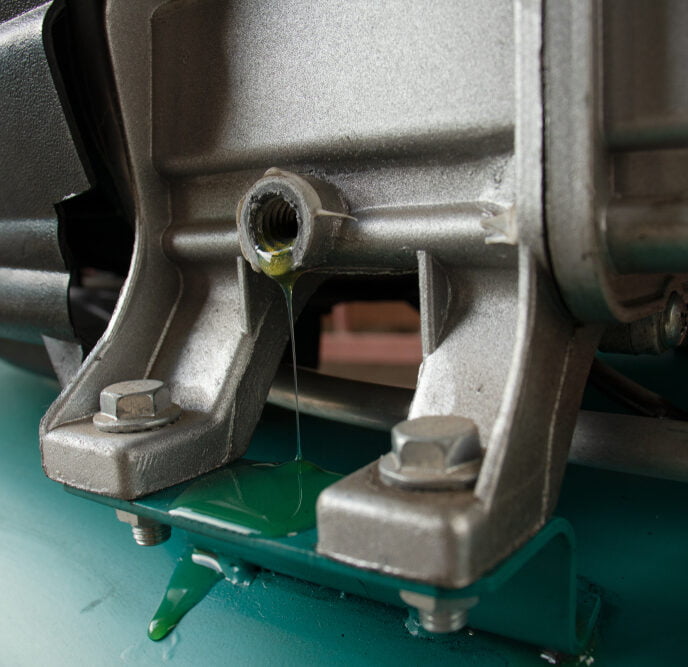How to Use an Air Compressor to Spray Paint

Whether you’re dealing with rust, peeling paint, or blemishes on your car, all you need is a proper workspace and the appropriate tools to paint the vehicle. In addition to needing a paint sprayer, power sander, quality paint, and other painting supplies, you’ll need an air compressor to power the sprayer. So, regardless of whether you’re a body shop mechanic or a car hobbyist looking to do some paint work, you’re going to need to know how to set up an air compressor properly.
How Do Air Compressors Work?
Air compressors are a reasonably simple machine for the versatility that they provide. They work by pushing air into a container and then pressurizing it. Then the pressurized air goes through an opening where it builds up. That built-up air is used to power a variety of tools, including sanders and paint sprayers.
Air compressors have an engine that changes electrical energy into kinetic energy, similar to a combustion engine. They use the same parts, including a crankshaft, piston, valve, head, and connecting rod.
They can deliver pressurized air in a strong enough flow that the automotive paint turns into a fine particulate, ideal for an even coat.
Can You Use an Air Compressor for Painting Cars?
Using an air compressor for painting cars is not just feasible but highly recommended. This tool is ideal if you’re after a smooth finish. Nonetheless, you have to choose an air compressor with care to ensure you’re using the right one for the paint job at hand.
How to Set Up an Air Compressor to Spray Paint a Car
Step 1:
Before starting anything, apply proper safety gear.
Step 2:
Connect your air compressor hose to the paint spray gun.
Step 3:
Double-check that the air compressor is delivering satisfactory CFM.
Step 4:
Mix your paint using the recommended proportions.
Step 5:
Test the pressure of your paint sprayer on a piece of cardboard to ensure it delivers a consistent flow of paint. If you are using an HVLP spray gun, you can use the knob on the side to adjust the spray pattern.
Step 6:
Carefully apply the first coat of paint to the vehicle’s surface.
Step 7:
Wait 12-24 hours to apply a second coat (if required).
Which Air Compressor to Get for Spray Painting Cars
Air compressors come in many sizes and models. Getting to know your options will help you pick the best tool or tools for your shop.
Types of Air Compressors
Single vs. Two-Stage
Single-stage air compressors are best used for low-demand applications. While you can use one for painting a car, it’s not ideal. Your best option is to buy a two-stage air compressor with 90 PSI that can spray at least 20 cubic feet per minute (CFM).
Reciprocating Air vs. Rotary Screw vs. Centrifugal Compressors
Reciprocating air compressors have a long life span and deliver plenty of air per horsepower. The downside is that they need regular maintenance, including oil filter changes, oil/air separator changes, and valve and piston maintenance. Rotary screw air compressors, on the other hand, only need minimal maintenance. However, they aren’t as efficient as reciprocating air compressors.
Centrifugal compressors are a powerful and efficient option to consider. Like rotary compressors, they don’t need extensive care and maintenance. However, bear in mind that choke and surge can occur at both ends of the performance curve.
Considerations for an Air Compressor
While there are differences between the three types of compressors, it’s most important to focus on how a compressor tolerates air displacement.
If you’re looking to use an air compressor for painting a vehicle, you’ll want to consider a few things.
For example, if you are doing touch-up work, your compressor needs will be different than if you are repainting the entire vehicle. In addition, what is your space availability? What other tools will you be using your compressor for?
The following considerations will help you determine what air compressor is best for you when learning how to use an air compressor to spray paint.
Tank size
The size of your air compressor’s tank is probably the most critical factor in deciding which compressor is best. The proper size tank will make your job extremely efficient.
If you want to paint an entire vehicle without refilling, a tank size of 50-60 gallons is recommended.
If you choose a smaller tank, you will need to refill it, sometimes more than once, if you are painting the entire vehicle. Smaller tanks also have more variability in the paint flow, so they can cause uneven coats. Lastly, you may have problems with the condensation of the paint with a smaller air compressor. This condensation happens because a smaller tank gets warm inside from constantly running and forms moisture as a result.
However, if you are concerned about space in your garage, you may want to consider a turbine-style spray paint gun. While not as effective as a 50-60 gallon compressor, the turbine-style paint gun is small and has built-in compressors.
CFM (Cubic feet per minute) rating
CFM is the amount of air per minute that the compressor pushes out, so a higher CFM makes spray painting more efficient. A higher CFM will also ensure that the paint is evenly applied and the final coat is uniform.
Your air compressor needs to have a higher CFM than your paint sprayer, so typically you’ll want a value between 14-18 CFM.
Air pressure
Air pressure (psi) is how much pressure is applied to the air coming out of the compressor. However, PSI is less important than CFM in painting cars.
The CFM is more vital because it delivers the proper paint atomization, while the pressure of the paint is not as crucial.
Many people use a stronger PSI when applying the clear coat, such as 20-25 PSI. However, the base coat PSI should be around 10-15.
Many people find that a high-volume (high CFM), low-pressure (low PSI) compressor, also called HVLP, is a good air compressor choice when you need to complete a paint job. HVLP compressors that deliver close to 20 CFM are best.
Horsepower
While not as crucial as tank size, CFM, or PSI, horsepower should still play a part in your decision. The higher the horsepower is, the more tools it can power simultaneously.
While most air compressors have a range between 1.5-6.5HP, some large standalone compressors go up to 15HP.
For optimal performance, a 3-6HP compressor is best.
Additional Air Compressor Parts To Consider for Optimal Spray Painting
Even a good air compressor may not come with the right parts for a spray-painting job. Before you start, it’s wise to stock up on needed parts ahead of time to avoid job delays.
A 50- to 60-liter tank is ideal if you want to paint an entire vehicle without pausing to refill the tank. You may need more than one type of compressor to handle different types of paints, as acrylics and lacquers have different atomization requirements. What’s more, you’ll want to keep air compressor parts on hand as filters and other parts must be replaced regularly. A high pressure air line is also a must.
SVI: The Leading Air Compressor Parts Provider
SVI offers a huge selection of air compressor parts along with all the other equipment and spare parts you’ll need to keep your auto shop running smoothly long-term. We have two ready-ship warehouses to ensure you get your orders without undue delay and our team offers unbeatable customer service to help you find the right tools and parts for your shop. Get in touch with us to find out more or to place an order for the items of your choice.
The recommended tank size for painting an entire vehicle is 50-60 gallons. In addition, look for an air compressor with close to 20 CFM and a PSI that ranges from 10-25. Finally, while horsepower is the least important of the factors, you’ll want an air compressor with a range of 3-6HP.
If you have any questions about your current air compressor and any repair parts, please don’t hesitate to contact us. As the leading supplier of industrial parts, including air compressors, we can get you back to business in no time. We offer parts ranging from air compressor controls, hose reels, pressure gauges, and replacement tanks. We look forward to helping you get back on your feet as soon as possible!


